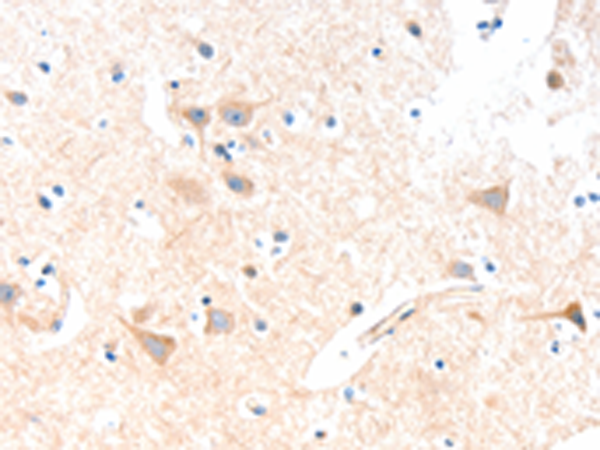
| WB | 咨询技术 | Human,Mouse,Rat |
| IF | 咨询技术 | Human,Mouse,Rat |
| IHC | 1/15-1/50 | Human,Mouse,Rat |
| ICC | 技术咨询 | Human,Mouse,Rat |
| FCM | 咨询技术 | Human,Mouse,Rat |
| Elisa | 1/1000-1/2000 | Human,Mouse,Rat |
| Aliases | TC1; THT1; TRMA; THMD1; THTR1 |
| Host/Isotype | Rabbit IgG |
| Antibody Type | Primary antibody |
| Storage | Store at 4°C short term. Aliquot and store at -20°C long term. Avoid freeze/thaw cycles. |
| Species Reactivity | Human |
| Immunogen | Fusion protein of human SLC19A2 |
| Formulation | Purified antibody in PBS with 0.05% sodium azide and 50% glycerol. |
+ +
以下是关于SLC19A2抗体的3篇参考文献及其摘要概括:
---
1. **标题**: *Cloning and functional characterization of a novel human thiamine transporter (hTHTR2)*
**作者**: Rajgopal A, et al.
**摘要**: 该研究通过克隆和功能分析鉴定了SLC19A2(hTHTR2)作为硫胺素转运体,并开发了特异性抗体。抗体用于免疫组化实验,揭示了SLC19A2在胰腺、胎盘等组织中的高表达,支持其在硫胺素吸收中的关键作用。
---
2. **标题**: *Mutations in SLC19A2 cause thiamine-responsive megaloblastic anemia associated with diabetes mellitus and deafness*
**作者**: Diaz GA, et al.
**摘要**: 研究通过分析TRMA患者的SLC19A2基因突变,利用抗体进行蛋白表达检测,发现突变导致转运体功能丧失,揭示了其与硫胺素代谢异常及多系统疾病(糖尿病、耳聋)的关联。
---
3. **标题**: *Immunolocalization of thiamine transporter 2 (ThTr2) in human kidneys*
**作者**: Lubarski I, et al.
**摘要**: 通过特异性抗体对SLC19A2进行免疫定位,发现其在肾脏近端小管细胞的顶膜高表达,提示其在肾硫胺素重吸收中的生理意义,为相关肾疾病研究提供依据。
---
4. **标题**: *Functional and structural analysis of SLC19A2 mutations in thiamine-responsive megaloblastic anemia*
**作者**: Stagg AR, et al.
**摘要**: 研究利用抗体验证SLC19A2突变体的细胞定位及稳定性,发现部分突变导致蛋白错误折叠或降解,阐明了TRMA的分子机制及抗体在突变蛋白检测中的应用价值。
---
以上文献覆盖了SLC19A2抗体在基因功能、疾病机制及组织定位中的关键研究,均为领域内重要参考。如需全文链接或补充文献,可进一步提供信息。
The solute carrier family 19 member 2 (SLC19A2) gene encodes a high-affinity thiamine (vitamin B1) transporter protein, essential for cellular uptake of thiamine, a cofactor critical for carbohydrate metabolism and neurological function. Mutations in SLC19A2 are linked to thiamine-responsive megaloblastic anemia (TRMA), a rare autosomal recessive disorder characterized by anemia, diabetes mellitus, and sensorineural hearing loss. SLC19A2 is predominantly expressed in tissues with high metabolic demands, including the intestines, placenta, and bone marrow.
Antibodies targeting SLC19A2 are vital tools for studying its expression, localization, and functional roles. They enable detection of the protein via techniques like Western blotting, immunohistochemistry, and immunofluorescence, aiding in the investigation of thiamine transport mechanisms and disease-related dysregulation. In research, these antibodies help validate SLC19A2 knockout models or assess protein levels in TRMA patients, where loss-of-function mutations impair thiamine absorption. Clinically, they assist in diagnosing TRMA by confirming reduced or absent SLC19A2 expression in affected tissues.
However, antibody specificity must be rigorously validated, as cross-reactivity with related transporters (e.g., SLC19A1 or SLC19A3) can yield misleading results. Commercial SLC19A2 antibodies vary in performance across experimental conditions, emphasizing the need for optimization. Despite challenges, these reagents remain crucial for unraveling the pathophysiology of TRMA and exploring therapeutic strategies to restore thiamine transport in deficient cells.
×